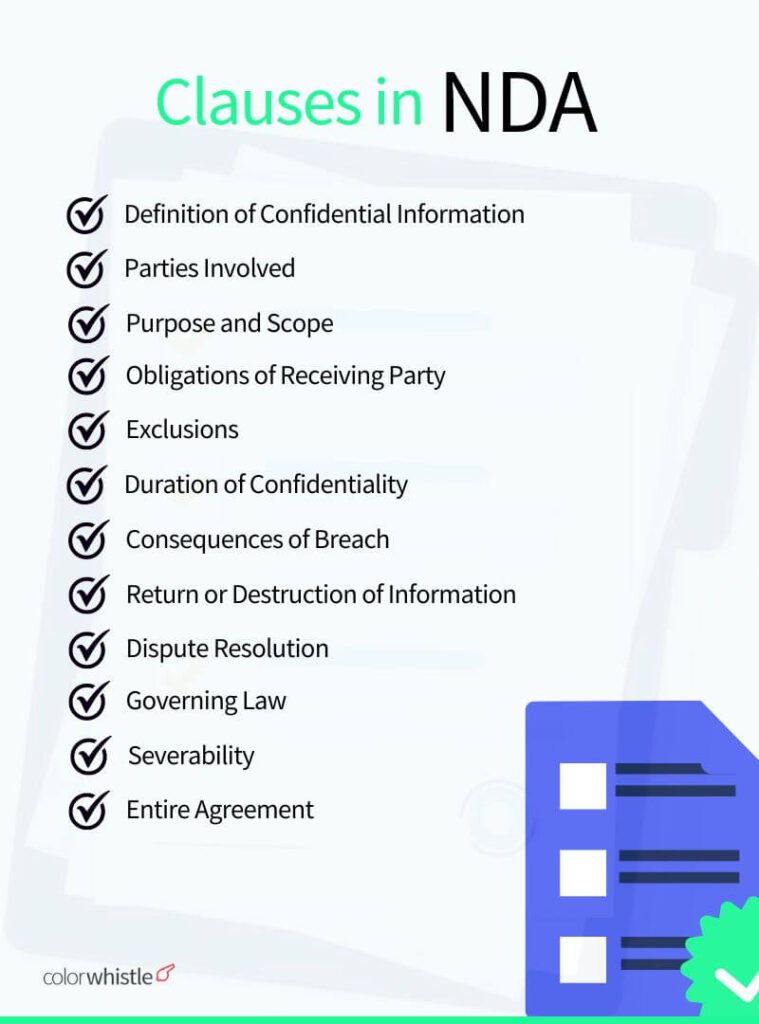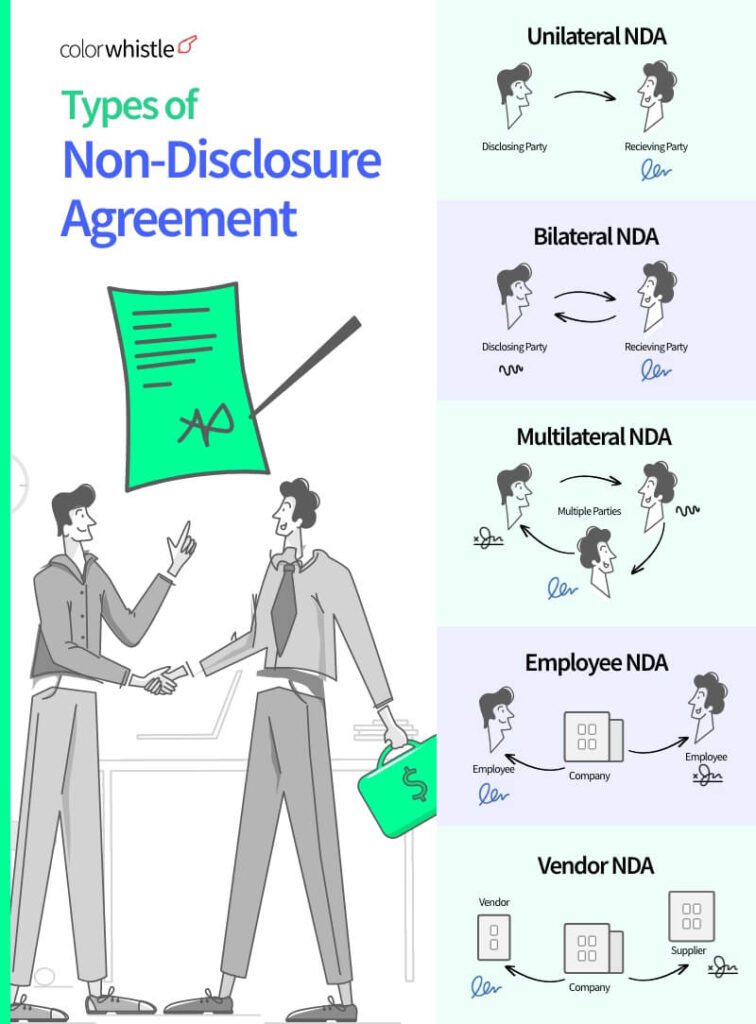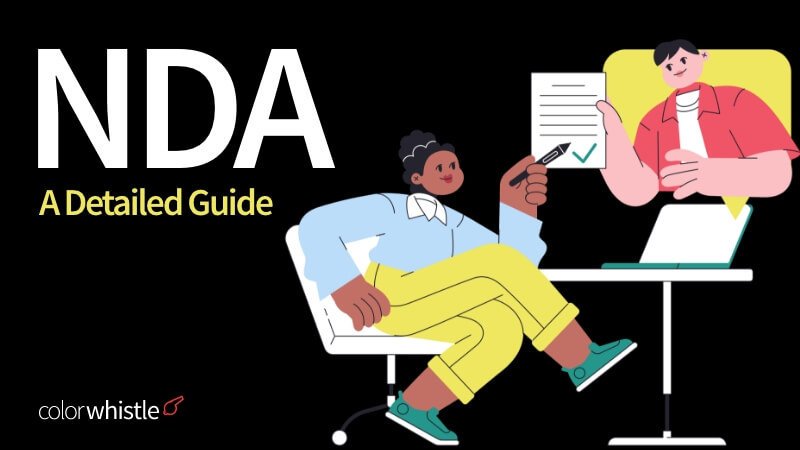What is an NDA?
An NDA or non-disclosure agreement is a legal contract between two parties. Here, one party will have sensitive information and the other will have access to that information.
NDAs are also labeled as confidentiality agreements, confidentiality disclosure agreements, and non-disclosure contracts. As both parties are maintaining a confidential relationship, they are bound not to share the information.
What is the Purpose of an NDA?
The non-disclosure agreement serves a dual purpose, encompassing both confidentiality and protection. A confidentiality agreement can shield a wide range of information, right from product specifications to client lists. Business strategies, test outcomes, and even restricted press releases or product evaluations can fall under the roof of an NDA.
By establishing a legal framework, an NDA ensures the preservation of ideas and information against theft or sharing with rivals or external parties.
An NDA performs three fundamental roles:
- Defining protected information: NDAs categorize information by distinguishing between what should remain confidential and what can be openly shared. This demarcation allows involved parties to operate freely within the established boundaries of the confidentiality agreement.
- Safeguarding sensitive information: Affixing a signature to an NDA imposes a legal obligation to maintain the confidentiality of sensitive information. Any unauthorized disclosure of this information constitutes a breach of the contractual agreement.
- Preserving patent rights: Given that the public disclosure of a pending invention can potentially invalidate patent rights, an NDA can shield inventors during the development of their novel products or concepts.
Also Read
When Would You Need an NDA?
Whether you are hiring new employees, looking for investors, or new partnerships and collaborations, there comes a point where confidential information needs to be shared with external individuals or entities. NDAs ensure the company navigates these endeavors securely.
So, when is an NDA necessary?
Products – When your organization engages in the sale or licensing of a product or technology, it becomes crucial to ensure that any data shared—be it technical, financial, or other proprietary information—remains confidential and cannot be distributed to third parties.
Employees – Given their access to sensitive and proprietary data, it’s essential to prevent your employees from sharing your organization’s confidential information while employed or after their departure.
Partners – During negotiations with potential partners or investors, the protection of shared information becomes paramount.
New Clients – When welcoming a new client, your organization might gain access to their confidential information. An NDA can safeguard your organization by delineating which information must remain undisclosed, thereby mitigating the risk of inadvertent legal repercussions.
Mergers and Acquisitions – In the process of selling your business, sharing sensitive financial and operational data becomes necessary not only with the acquiring entity but also with intermediaries and brokers. An NDA guarantees the security of this data.
Clauses in NDA
Key clauses that you should have in every non-disclosure agreement,

Definition of Confidential Information
This clause outlines the types of information considered confidential. It specifies what falls under the protection of the NDA, whether it’s trade secrets, financial data, intellectual property, customer lists, etc.
Parties Involved
This clause identifies the parties bound by the agreement. It names the disclosing party (the one sharing the confidential information) and the receiving party (the one receiving the information).
Purpose and Scope
Here, the purpose of sharing confidential information is stated, along with the scope of its usage. This defines the context in which the data can be accessed and used.
Obligations of Receiving Party
This clause outlines the responsibilities of the receiving party. It specifies that the receiving party must keep the information confidential, use it only for the specified purpose, and prevent unauthorized access or disclosure.
Exclusions
Some NDAs include clauses that detail information that is not subject to confidentiality, such as information already in the public domain or notification independently developed by the receiving party.
Duration of Confidentiality
This clause specifies the duration for which the confidentiality obligations remain in effect. It can be a specific time frame or continue indefinitely.
Consequences of Breach
This section explains the repercussions if the receiving party breaches the terms of the agreement. It may outline potential legal actions or remedies available to the disclosing party.
Return or Destruction of Information
Upon termination of the agreement, this clause can stipulate that the receiving party must return or destroy any confidential information they possess.
Dispute Resolution
In case of disputes arising from the NDA, this clause outlines the methods for resolving conflicts, whether through negotiation, mediation, arbitration, or litigation.
Governing Law
This clause specifies which jurisdiction’s laws will govern the interpretation and enforcement of the NDA.
Severability
This clause states that if any portion of the NDA is found unenforceable, the remaining provisions will still hold.
Entire Agreement
This clause confirms that the NDA represents the complete understanding between the parties regarding the confidentiality of the information.
What Information is Protected in an NDA?
An NDA (Non-Disclosure Agreement) serves to safeguard a wide spectrum of sensitive and confidential information across various business contexts. The scope of protected information can encompass trade secrets, intellectual property such as patents and copyrights, proprietary financial data, customer and client lists, intricate product designs, marketing strategies, software code, research and development findings, employee details, negotiation specifics, legal strategies, and even healthcare or medical information in relevant sectors.
This legal contract ensures that the disclosed information remains confidential and cannot be shared with third parties, preserving the competitive edge, privacy, and integrity of the involved parties.
It’s crucial for the NDA to expressly define the categories of information protected, thereby establishing a clear framework for maintaining confidentiality and preventing unauthorized disclosure or use.
Regarding an employee-employer relationship, the NDA includes a confidentiality agreement where the employee is not allowed to disclose information not only during the time of employment but also for a specific period even after the job ends.
Types of NDA
Non-disclosure agreements (NDAs) come in various types, each tailored to specific business circumstances and the nature of the confidential information being shared. Here are some common types of NDAs:
Unilateral NDA: This is the most common type, where one party (the disclosing party) shares confidential information with another party (the receiving party). The receiving party agrees not to disclose or use the information for their benefit.
Bilateral NDA (Mutual NDA): In this arrangement, both parties exchange confidential information and agree to keep each other’s information confidential. It’s often used when both parties are sharing sensitive data.
Multilateral NDA: This involves three or more parties entering into an NDA. It’s helpful when multiple entities collaborate on a project, and each needs to protect their confidential information.
Employee NDA (Staff NDA): Used when employees are privy to confidential information during their employment, this agreement ensures that employees won’t disclose sensitive information outside their job responsibilities.
Vendor NDA (Supplier NDA): When a company shares confidential information with its vendors or suppliers, this type of NDA ensures that the vendor won’t misuse or disclose the information.
Consultant NDA (Freelancer NDA): When hiring freelancers, contractors, or consultants who need access to proprietary information, this agreement safeguards the client’s sensitive data.
Investor NDA (Financier NDA): Entrepreneurs seeking investment might use this NDA to protect their business ideas while discussing investment opportunities with potential investors.
Partnership NDA (Joint Venture NDA): When two companies are considering a partnership or joint venture, they might use this NDA to protect the confidential information shared during negotiations.
Technology NDA: Particularly relevant in the tech sector, this NDA ensures that proprietary technology, software code, algorithms, and technical data remain confidential.

How to Create an NDA?
While creating and signing a non-disclosure agreement you should use specific language that defines the confidential information, the parties involved, and the scope of the agreement. Usage of broad language may lead to various miss interpretations that are not enforceable in a legal dispute. NDA creators also need to remember that they are not supposed to disclose the information that needs to be covered in the agreement before signing the contract. Also, the non-disclosure agreement will never cover the already known information.
You don’t have to get a lawyer to create and sign the NDA but, if you want to protect confidential information and if it is essential, it’s a good move to get a legal expert to check it. You can even make use of the NDA template tools that are available in the market. Using the NDA template will eliminate the time that you need to create it from scratch. Some well-known NDA template tools are Jotform, Juro, Startnearshoring, Checkbox, DocuSign, Sign.Plus and more.
Also Read
What are the Consequences When You Violate an NDA?
The consequences of violating the non-disclosure agreement vary depending on the terms of the agreement, the information that has been disclosed, and also depends on the jurisdiction in which the agreement has been entered.
The party affected by violating the NDA agreement can take legal action by filing a lawsuit or pursuing alternative dispute resolution. The consequences can include financial penalties, reputation damages, termination of the contract, and can also result in criminal charges if the disclosed data is related to government secrets or any other sensitive information.
In general, violating an NDA can lead to significant problems which include financial/legal penalties, and damaging your reputation. Companies and people need to treat NDAs seriously and follow the rules in the agreement to avoid facing these adverse outcomes.
Signing an NDA
Signing an NDA (Non-Disclosure Agreement) is a formal commitment where parties agree not to share confidential information. The process involves understanding the agreement’s terms, acknowledging the sensitive nature of the shared information, and agreeing to legal consequences if the terms are breached. Typically, both parties sign the document, and their signatures indicate their consent to abide by the agreement.
This step encourages trust and sets clear boundaries for handling proprietary data. It’s advisable to carefully review the NDA and seek legal advice if needed before signing. Once signed, the NDA helps protect confidential information and establishes a legal framework to address any violations.
There are various E-signature software that would help in eliminating the need for physical documents for recording signatures. Some popular E-signature software includes Dropbox, Panda Doc, Adobe Acrobat, DocuSign, and more.
To know more about various E-signature software check this link.
Why are NDAs Crucial for Businesses?
NDAs (Non-Disclosure Agreements) are crucial for businesses because they safeguard sensitive information, ensuring that proprietary data, trade secrets, and strategies remain confidential when shared with employees, partners, or third parties. This protection fosters trust among collaborators, encourages innovation, and prevents unauthorized use or disclosure that could harm a company’s competitive edge.
NDAs also establish a legal framework for holding parties accountable, deterring breaches that could result in costly legal actions, financial losses, and reputational damage. By securing valuable assets and promoting a culture of trust, NDAs play a vital role in preserving a business’s integrity and success in a competitive marketplace.
NDA, MSA, SOW, SLA – Confidentiality Agreements
NDA – Non-Disclosure Agreement
- NDA is a legal document that builds a contract between two parties that includes confidential information.
- The primary goal of this agreement is to protect sensitive information, and the parties mustn’t disclose the data
MSA – Master Service Agreement
- A Master Service Agreement (MSA) is a comprehensive contract that outlines the terms and conditions under which two parties will work together on multiple projects or transactions over some time
- It serves as a foundational agreement that establishes the general terms, responsibilities, and expectations for the business relationship between the parties
- MSA defines terms such as payment structures, intellectual property ownership, dispute resolution mechanisms, and confidentiality, it typically doesn’t include project-specific details
SOW – Statement of Work
- A Statement of Work (SOW) is a detailed document that outlines the specific tasks, responsibilities, deliverables, timeline, and expectations for a project or service
- It is typically used in contracts to provide a clear understanding of what needs to be accomplished, how it will be done, and the scope of work involved
- It serves as a roadmap that guides the project from start to finish, ensuring everyone is on the same page regarding the work to be performed
SLA – Service Level Agreement
- A Service Level Agreement (SLA) is a formal contract or agreement between a service provider and a client that outlines the specific terms, conditions, and expectations related to the quality and level of service to be provided
- SLAs define the scope of the services, the performance metrics that will be measured, the responsibilities of by both parties and the consequences of not meeting the agreed-upon service levels
Non-Disclosure Agreements (NDAs) serve as essential tools for safeguarding sensitive and confidential information. They offer a range of advantages, including the protection of proprietary data, the preservation of business secrets, and the facilitation of open communication. Furthermore, NDAs provide legal recourse for parties if confidentiality is breached and can be customized to suit specific needs.
However, it’s essential to consider the potential disadvantages. NDAs may sometimes hinder innovation and collaboration, discouraging the free flow of ideas and information. Striking the right balance between protection and collaboration is crucial when deciding whether to use an NDA, as it should align with the specific goals and circumstances of the parties involved.
At ColorWhistle, whenever the clients demand for an NDA we ensure to sign and adhere to the non-disclosure agreement for those projects, and we have mentioned it all our engagement models.
What’s Next?
Now that you’ve had the chance to explore our blog, it’s time to take the next step and see what opportunities await!





